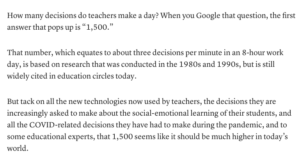GRWM! An average day of scrolling, analyzing, and validating info for a teacher!
 Hey guys! Get ready with me while I take you on a journey of what my day looks like for scrolling, analyzing, and validating information as a teacher! Just kidding…I am not a Tik Tok influencer…
Hey guys! Get ready with me while I take you on a journey of what my day looks like for scrolling, analyzing, and validating information as a teacher! Just kidding…I am not a Tik Tok influencer…
Most mornings, by 6 am I have already checked “home page” apps; I do a quick check or scroll through Facebook, Instagram, Snapchat, personal email, work email – in that order – all before even getting out of bed most days. I can’t decide on the health factor of this routine though. In some sense, I am filled in right away and then don’t feel the need to check in again until much later in the day (other than work emails throughout the day), but on the other hand, I don’t know if it is healthy to start my day filled with thoughts, feelings, and stressors that are created through having to filter through the material on these apps.

After the mad dash of getting everyone ready and where they need to be for the day (which I think every parent who does this deserves a medal for by the time they arrive at work), my day entirely consists of making sense of information in a variety of forms. This is why teaching is so mentally and emotionally exhausting. As a high school English teacher, the primary focus for content in my classroom is making sense of information in regard to the world around us. My classes have to listen to podcasts, watch videos/documentaries, read books/poems/short stories, and learn from one another to make sense of the world around them, therefore I will have had to do that for the material prior to presenting it to them.
By lunchtime, I have typically not looked at my phone yet and I actually try to avoid doing so for two reasons:
- I have my own homework to be working on during the lunch hour as time is limited outside of work hours and
- I will simply get distracted by a bombardment of new information that has accumulated since my 6 am check in and at this point in the day, I don’t have time or energy to spend on new social information that will take away from my productivity. I have actually turned of all notifications except for text messaging in order to stay focused and productive.
After school is done for the day, it feels like another mad dash of ‘get as much done as possible before picking up the kids’. I don’t typically feel this way during the school year, but with returning from maternity leave half way through the semester this year, I am constantly adjusting plans so they work for the students I am just getting to know in addition to the heaps of marking that seem to naturally come with the subject territory, all in addition to having two night classes of my own.
A quick, intentionally mindless scroll before going to sleep typically ends the 24-hour cycle of analyzing and validating information for me.
 In terms of analyzing and validating information, I feel like that is a skill teachers use and sharpen regularly. Teachers are also skilled at, like Chantal’s video and article mention, ethically responding to information throughout the day to set boundaries and expectations. Sometimes this is in the form of finding new sources or materials for our classes, in which case we have to ensure we are presenting accurate information and have to be fact checkers of sorts. This also pertains to updating information we have used in the past. For example, I teach The Kite Runner novel and prior to reading I have students learn a little bit about Afghanistan, how the Taliban gained power, and laws in place. What I have to update each time I teach this novel is the current state and status of Taliban power and laws in Afghanistan to ensure I am providing accurate and up-to-date information and then point out if there are any conflicting, out-of-date, or context-creating pieces of information as we read through the novel to combat the misperceptions that are often created in social media about this topic, which either elicit strong, uninformed emotions OR complete complacency from students, a notion Kim’s video aptly addresses. To connect with Kendyll’s video and article, as a result of EC&I 832, I am trying to incorporate ways of having my students be conscious of and explore social media in aspects that directly connect to course-specific curricular themes as well as to counter the implications of filter bubbles and algorithms, as Jordan mentions, by attempting minimize what the internet it hiding from them and expand their worldview. For example, my A30 class will soon be exploring Indigenous Tik Tok to gather and gain Indigenous perspectives in relation to current events, historical events, connecting to their novel, and developing understanding of culture through Tik Tok as a platform for information.
In terms of analyzing and validating information, I feel like that is a skill teachers use and sharpen regularly. Teachers are also skilled at, like Chantal’s video and article mention, ethically responding to information throughout the day to set boundaries and expectations. Sometimes this is in the form of finding new sources or materials for our classes, in which case we have to ensure we are presenting accurate information and have to be fact checkers of sorts. This also pertains to updating information we have used in the past. For example, I teach The Kite Runner novel and prior to reading I have students learn a little bit about Afghanistan, how the Taliban gained power, and laws in place. What I have to update each time I teach this novel is the current state and status of Taliban power and laws in Afghanistan to ensure I am providing accurate and up-to-date information and then point out if there are any conflicting, out-of-date, or context-creating pieces of information as we read through the novel to combat the misperceptions that are often created in social media about this topic, which either elicit strong, uninformed emotions OR complete complacency from students, a notion Kim’s video aptly addresses. To connect with Kendyll’s video and article, as a result of EC&I 832, I am trying to incorporate ways of having my students be conscious of and explore social media in aspects that directly connect to course-specific curricular themes as well as to counter the implications of filter bubbles and algorithms, as Jordan mentions, by attempting minimize what the internet it hiding from them and expand their worldview. For example, my A30 class will soon be exploring Indigenous Tik Tok to gather and gain Indigenous perspectives in relation to current events, historical events, connecting to their novel, and developing understanding of culture through Tik Tok as a platform for information.
Teachers are also constantly analyzing and validating information from interactions with students, parents, and colleagues. This Education Week article says that teachers make AT LEAST 1,500 decisions in a day, creating decision fatigue, which I whole-heartedly relate to (also maybe why the general public doesn’t understand why we ‘only work 10 months a year’ *eye roll*..we are tired!!). Teachers have to be aware of context and reliability of sources in all cases, which is probably why, for the most part, teachers have high interpersonal awareness and skills, making teachers quick to catch fallacies in media and other information we digest on a daily basis.

Hi Jacquie! I am a little late for commenting, but as we all know work and life can get a little busy. I wanted to let you know that I loved this blog post. It made me consider how much time I spend on my phone during the day and actually log it – it was surprising! Have a wonderful Winter break.